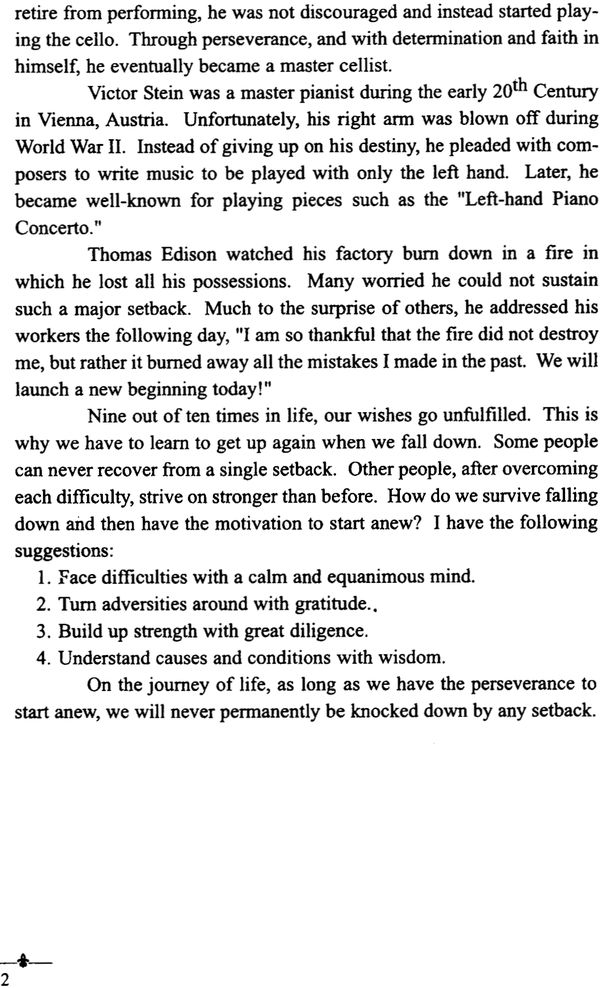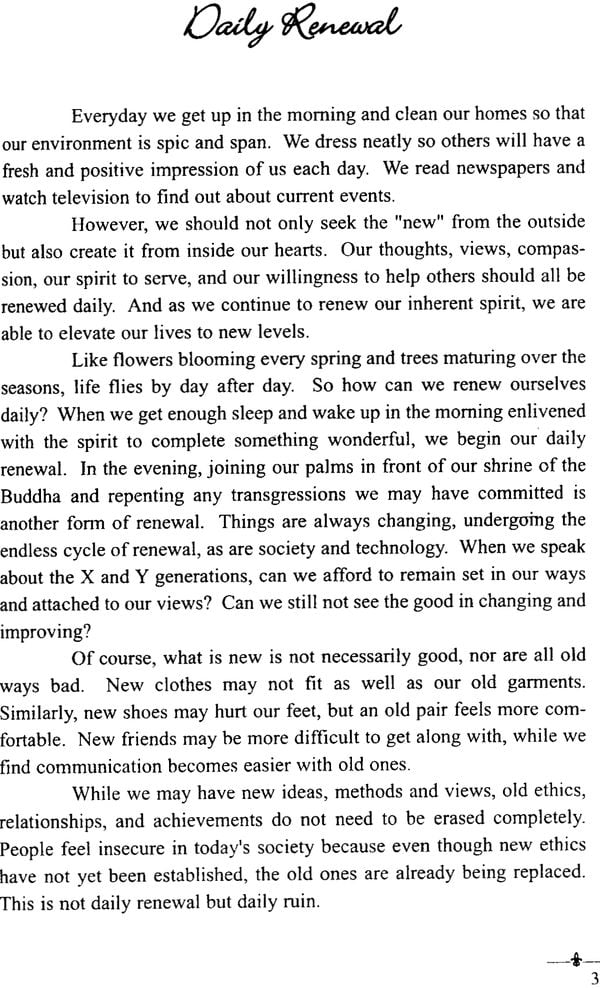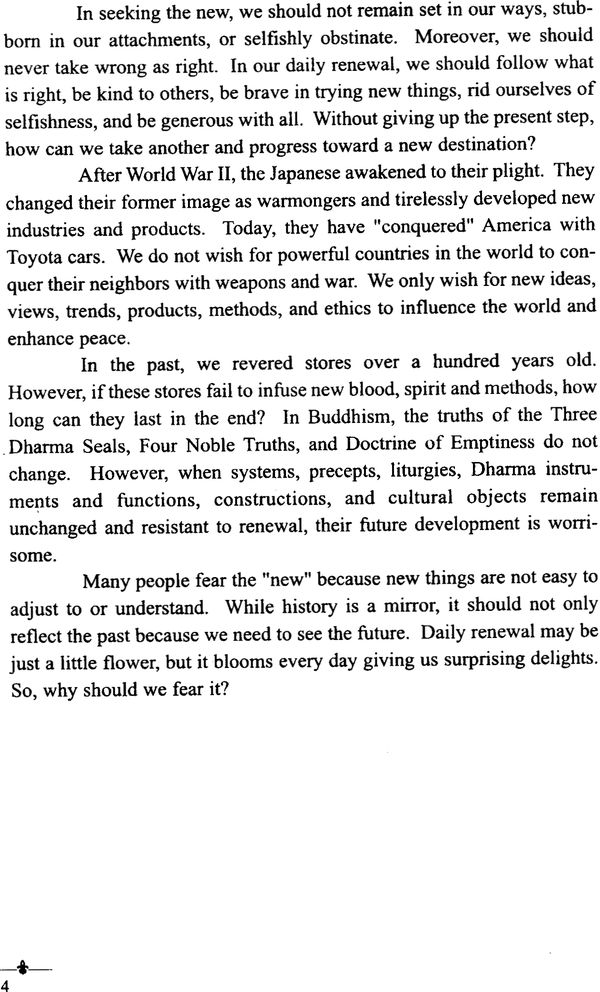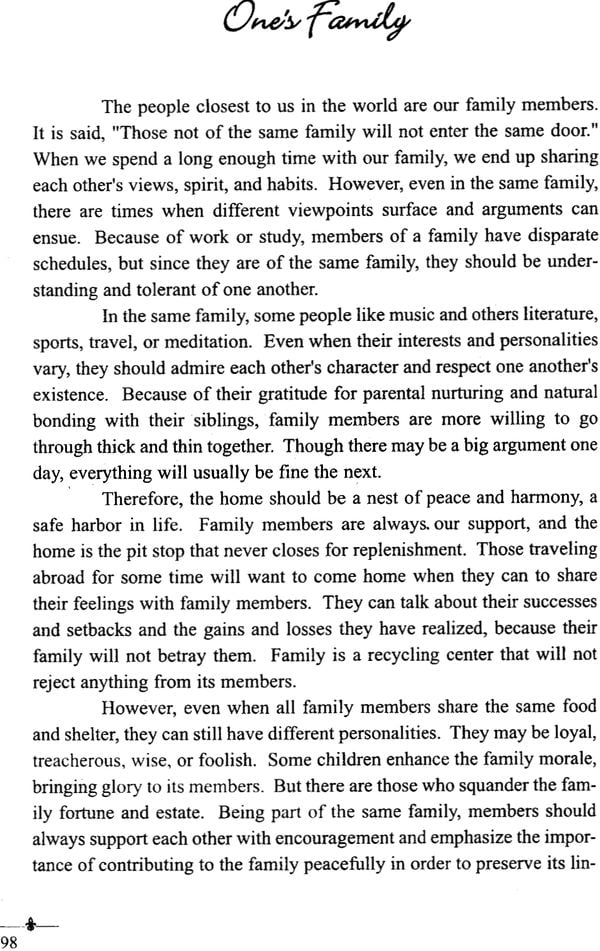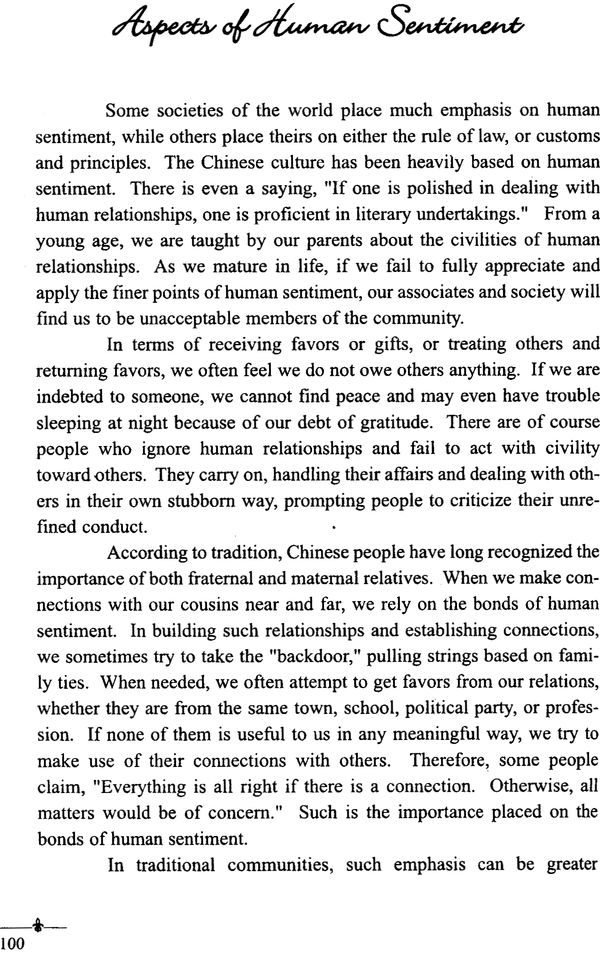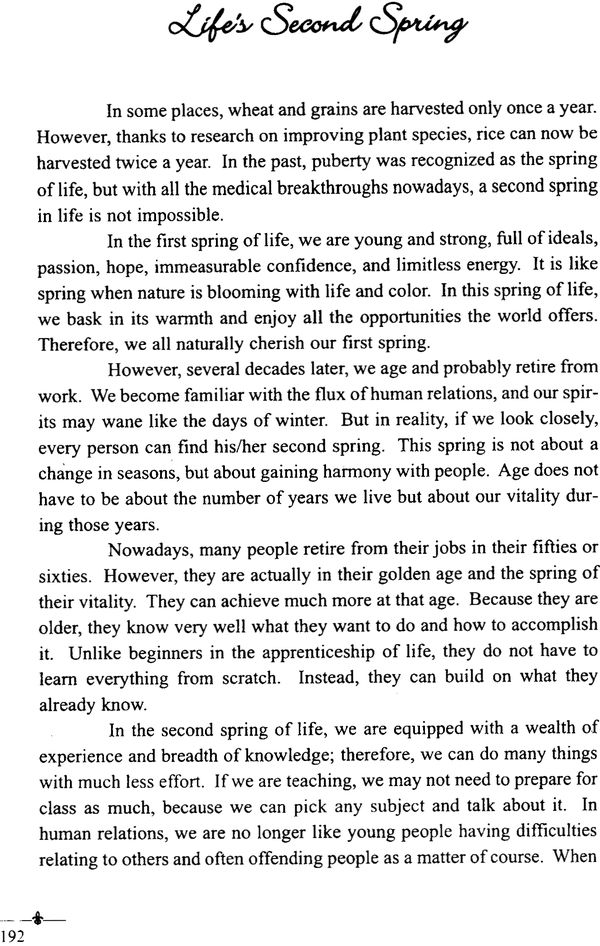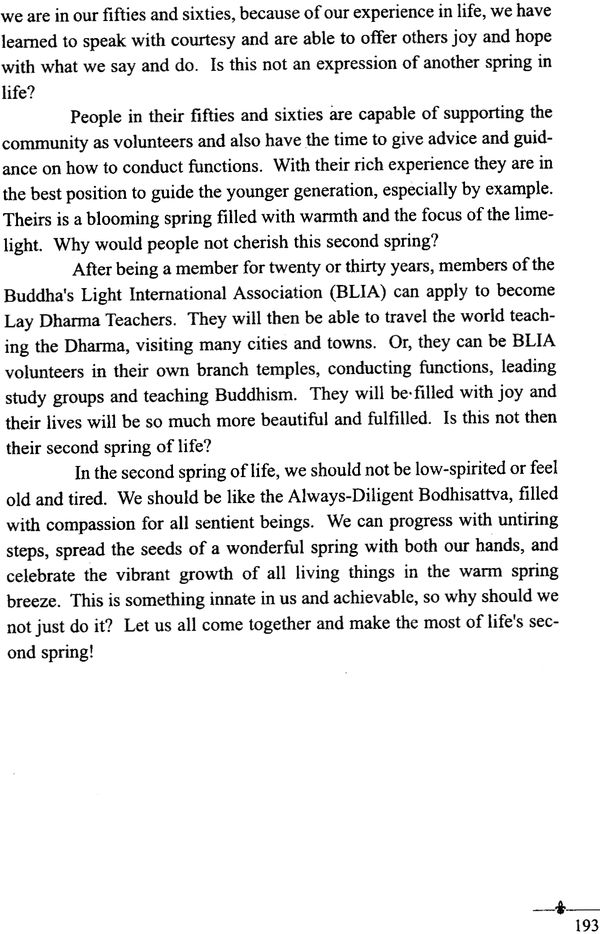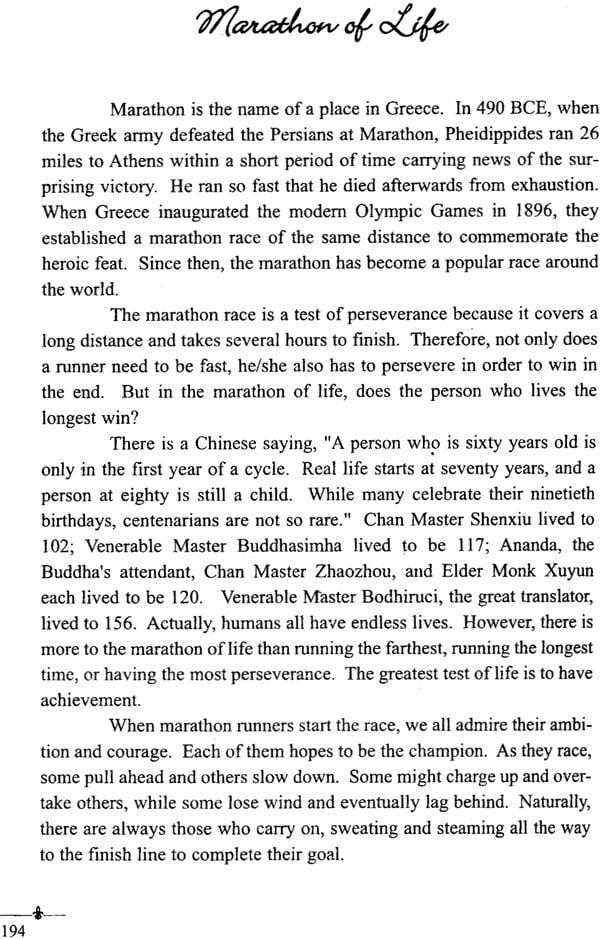
Tending Life's Garden - Between Ignorance and Enlightenment
Book Specification
| Item Code: | NAJ175 |
| Author: | Venerable Master Hsing Yun Translated by Venerable Miao Hsi and Cherry Lai |
| Publisher: | Buddha Light Art and Living Pvt Ltd |
| Language: | English |
| Edition: | 2012 |
| ISBN: | 9789382017202 |
| Pages: | 224 |
| Cover: | Paperback |
| Other Details | 8.5 inch X 5.5 inch |
| Weight | 240 gm |
Book Description
“A garden of plum blossoms and lush willows will look forlorn if they are surrounded by withered branches and dead leaves. When our morals and character are flawed , we cannot win the respect of others no matter how great our accomplishment . therefore, we should never stop tending to our life’s garden , trimming and ridding if of it s impurities and decaying matter . “
In tending Life’s Garden , Volume Six of the Popular Between Ignorance and Enlightenment series, venerable Master Hsing Yun meditates on this theme of tending to life with wisdom and compassion. He charts a sounds and empathetic course for tending to the cause and conditions of human suffering . This volume also offers ways to celebrate and enhance the beauty in the garden of life , inspiring people of all generations and walk of life to realize their potential for growth.
Tending to life’s garden is ultimately about renewal just as trimming a rose bush is about excepting it to bloom more beautifully. Venerable Master Hsing Yun captures this spirit when he remind us , “when we pour our life in to the stream of the universe , the whole world will jump and dance With us . then , any season, any age can be the spring of life.”
It is a privilege for me to contribute this preface as a member of the team of translation and editors that worked on the publication of Tending Life’s Garden , the sixth volume in English of the popular Between Ignorance and Enlightenment series by venerable Master Hsing yun. In many ways the process of editing or translating the manuscript is not that different from the experience of a fully engaged reading of this book. The this is why I hope What I have to share as an editor will be of some relevance to those who are about to embark on the same profound journey of sound optimism , practical guidance and spiritual liberation I experienced in editing this book I believe Tending Life’s Garden can enrich and eighteen all those who are willing to open their hearts and minds to its wisdom and faith . In reading it with diligence and care , we are in essence taking the first key step in “ tending to the garden “ of our own lives. Each chapter reminds us of what we need to “trim “ from our day to day habits, and teaches us how best to “fertilize” our spirit and mind. As Venerable Master Hsing Yun puts it in the title chapter.
A garden of plum blossoms and willows will look forlorn if they are surrounded by withered branches and dead leaves . When our morals and character are flawed , we cannot win the respect of other no matter how great our accomplishment s. therefore, we should never stop tending to our life’s garden , timing and riding it of its impurities and decaying matter.
My reading of the first five volumes in the Between Ignorance and Enlightenment series left a deep a and lasting impact, especially in terms of helping me appreciate how the Dharma can be infused in our daily lives: however , even that realization does not compare to what I have gained from working on Tendering Life’s Garden . It was truly one of those rare instances where the line between “work” and personal cultivation was wonderfully blurred. I am sure much of the reason lies I how deeply immersed I was in the content While editing and proofreading chapter after chapter. Yet , it is also true that there is a powerful and coherent logic that runs throughout this volume that made it particularly illuminating and instructive for me. This Logic reveals itself almost in an organic manner , not Unlike the blossoming of a flower or the sprouting of leaves on a tree.
In keeping to the theme of “tending life’s garden “ the book opens with a sequence of chapter that emphasize the need to “trim” and discard the undesirable and decaying aspects of our “garden” in order to provide space and conditions for new and more vibrant growth in our lives. Using the Chan metaphor of “Going through death ,” for example, Venerable Master Hsing Yun reminds us that sometimes renewal and rebirth require u first to discard our self , to let “go through death” so to speak , so that a better and more noble self be born . This means that without death there can be no rebirth or new life ; it is needed just as dead leaves are needed as compost to foster new growth in nature. The same applies to Unwholesome or harmful habits we may have . As long as we are able to repent and rid ourselves of such sources of suffering and pain , we are able not only to save ourselves, but to assure ourselves of a brighter future . as Venerable Master Hsing Yun affirms, “ In the curse of our life’ within the day or even the hour , we should constantly ‘go through death ,’ to change our bad ways.. when people can transform themselves completely, and turn over a new leaf after going throughout death , it is indeed something to celebrate . “ This promise of turning over a new leaf captures the spirit of optimism and hope that pervades throughout Tending Life ‘s Garden.
Yet, Venerable Master Hsing Yun is also quick to remind u that hope and optimism does not come without the necessary diligence and faith in practicing compassion, loving-kindness, Joy and equanimity – the four Immeasurables espoused in Buddhism – on a daily basic again, just as a gardener cannot except to cultivate a vibrant and prolific garden without tending too it with constant love and care, we also cannot except to live healthy and fulfilling lives without applying wisdom and discipline to our everyday conduct in life. For this reason , tendering Life’s Garden is full of specific guidance on how we should tend to our moral , spiritual and emotional “gardens.” Discussing topics as poignant and diverse as “the Art of refusing .” “Good, Yet Useless People .” “Sandwich Cookies” and “I assumed,” Venerable Master Hsing Yun Draws from his wealth of spiritual and worldly knowledge to offer astute and practical guidance on how we should face different life situations , as well as how he should interact with others. In one chapter, he advocates society putting a greater emphasis on a “life skills education.” Indeed much of tending Life ‘s Garden is devoted to that very mission. another chapter, Venerable Master Hsing Yun points t the importance of having and abiding by “maxims” in life . Likewise, the entire volume is so rich in substance and eloquent in expressions that one can find a meaningful “maximum” to follow in almost every chapter.
We should not confuse such an emphasis on adopting “maxims” or pursuing a “life skills education “ with a rigid and dogmatic approach on how to live . While it is true that venerable Master Hsing Yun provides us with sounds guidelines in tending Life’s Garden , it is equally true that he approaches the challenges of living well more as an art than as dogmatic practice. For this reasons , Tending Life ‘s Garden is also very rich in artistic metaphors that help to capture the subtleties of living creative and dynamic lives full of meaningful interest and pursuits. Chapter such as “Sculptures Ourselves” and “the mind painter “ all rely on the metaphors of art to convey the importance of using positive Imagination and wholesome artistry to enhance the quality of our life . at the same time , they remind us that an aesthetic perspective is essentials for appreciating the many sources of beauty that is all around us. Venerable Master Hsing Yun conveys this Uplifting outlook on life eloquently when he writes.
We all come into world with the potential for happiness. There is the beauty in nature , such as that of mountains and river s, for us to enjoy . We can admire trees , Flowers and stars in the sky . we have our families and loved ones to give us tender loving care , society to fulfil our every need, and people with whom we can many meaningful relationship.
In saying this , he reminds us that life itself is a garden filled with infinite sources for hope, beauty and redemption. As long as we tend to it with loving - kindness, diligence and wisdom, we can all enjoy its teeming beauty and abundant harvest. Picking up and reading this life - affirming and spirit –enriching books is the key step to tending our life’s garden . but taking its lesson s and applying them o how we live is crucial for assuring lives of infinite possibility and growth.
Tending Life’s Garden is Ultimately about affirmation and renewal , just as timing a favourite rose is about excepting it to bloom more beautifully. Venerable Master Hsing Yun captures this spirit perfectly when he writes, “ when we pour our life into the stream of the universe , , the whole world will jump and dance with us . then , any season any age can be the spring of life .”
Contents
| Preface | i |
| Acknowledgements | v |
| A brand New Start | 1 |
| Daily Renewal | 3 |
| Accepting Reality | 5 |
| Tests in Life | 7 |
| Resolving Problems | 9 |
| Self-Entrapment | 11 |
| overcoming Setbacks | 13 |
| Going Through Death | 15 |
| turning Ourselves Around | 17 |
| Self-Adjustments | 19 |
| Habitual tendencies | 21 |
| Letting Go of One's status | 23 |
| To Adapt and Adjust | 25 |
| Reforming Ourselves | 27 |
| Ridding Ourselves of Suffering and Sadness | 29 |
| Knowing the way | 31 |
| Regeneration | 33 |
| Replacements | 35 |
| Tending Life's Garden | 37 |
| Life Skills education | 39 |
| Practical Knowledge | 41 |
| Conducting ourselves | 43 |
| Body Languages | 45 |
| Poise | 47 |
| Sportsmanship | 49 |
| The Importance of Expressions | 51 |
| Cryonics | 53 |
| Two-faced People | 55 |
| To Walk in Another 's Shoes | 57 |
| Likes and Dislikes | 59 |
| The Art of Refusing | 61 |
| Not going Against another 's Wishes | 63 |
| Sandwich Cookie | 65 |
| Understanding the Greater Good | 67 |
| Good, Yet Useless People | 69 |
| Helping Other Succeed | 71 |
| To Perform | 73 |
| Think , Speak , Listen , Act | 75 |
| Setting a good Example | 77 |
| Self-Deprecation | 79 |
| I Assumed | 81 |
| The Thought Process | 83 |
| Life Planning | 85 |
| Quality of Life | 87 |
| The Tracks of Life | 89 |
| To Save and Prepare | 91 |
| One's Footing in Life | 93 |
| Marriage | 95 |
| One's Family | 98 |
| Aspect of Human Sentiments | 100 |
| The Treasure of a Great Friendship | 102 |
| The Value of Good Neighbours | 104 |
| The Ways of Home Life | 106 |
| Nurturing body and Nature | 108 |
| Self-Nature | 110 |
| Moral Life | 112 |
| Maintenance | 114 |
| Self-Education | 116 |
| Governing The Mind | 118 |
| Purifying the Mind | 120 |
| Losing Weight | 122 |
| The Meaning of Rest | 124 |
| Sculpturing Ourselves | 126 |
| Maxims | 128 |
| To Rely on Ourselves | 130 |
| Develop Our Potential | 132 |
| Self-Assurance | 134 |
| Self-Respect | 136 |
| Having Meaningful interests | 138 |
| Having Taste in Life | 140 |
| Interests and Enthusiasm | 142 |
| New branches on an Old Trunk | 144 |
| Passing the Baton | 146 |
| Getting On and off Stage | 148 |
| One's Standing in Life | 150 |
| Places and Positions | 152 |
| Teamwork and Division of Labour | 154 |
| The Mind Painter | 156 |
| The Wonder of Contemplation | 158 |
| On Increasing Positive Thought | 160 |
| Self-Confidence | 162 |
| Motivating Ourselves | 164 |
| Expectations and Aspirations | 166 |
| The Spring of Life | 168 |
| Spreading Joy | 170 |
| Interpretations | 172 |
| The Study of Life | 174 |
| The Metaphors of Life | 176 |
| Enigmas | 178 |
| Having Art in Our Lives | 180 |
| the Painting of Life | 182 |
| The True Colors of Life | 184 |
| Human nature | 186 |
| A new Spring for the Elderly | 188 |
| Life's Golden Age | 190 |
| Life's Second Spring | 192 |
| Marathon of Life | 194 |
| The Transmigration of Life | 196 |
| The End of Life | 199 |
| The Non-Duality of Living and Dying | 201 |
| Glossary | 203 |

